Barb Drozdowich's Blog, page 33
December 5, 2016
Re-inventing the Wheel – part 2 of Formatting for Paperback

Today we are going to continue with our discussion of formatting for paperback.
Last week I asked the question of why you would want to list your book on IngramSpark. I had several correct answers sent my way. Yay!
Before I share the answer, let’s do a mini review…
You want to make the creation as easy as possible and as normal as possible – in other words, you want to find a simple process to create your PDF and not combine a whole bunch of activities that end up taking you hours of work. In addition, you want your book to look like the industry standard. You want your book to be noticed for the outstanding story, not the funky formatting. You don’t want the formatting to be noticed, essentially – you want it to exist to be in the background.
Many authors upload a Word doc directly to CreateSpace and that can be done, but if you are going to upload to IngramSpark, you will need a PDF, so bypass the Word doc and go straight to the creation of PDF – remove one step in the process.

As I said in last week’s post – stop contorting yourself – find a straightforward process. As we move back towards last week’s question of why to upload to IngramSpark, let’s talk about the requirements for uploading to that platform. Although there is mention briefly of a PDF created from a Word doc, the guide that IngramSpark produces to guide authors in the creation of files needed only talks about PDFs generated from Adobe’s InDesign or Quark.
In actual fact the help documents state: “Please note that PDFs created using the “save as” function from MS Word are not supported.”
If you know differently, please correct me, but as far as I know, you can’t just upload any old PDF to IngramSparks.
Why would you pay the fee and upload to the Ingram Spark list?
The short answer is so that your book is available for purchase from everyone, everywhere.
 There is an excellent article about having your paperback available on both CreateSpace and IngramSpark. I was originally published on the Self-Publishing Advice blog by Karen Myers. The title is “How to Use CreateSpace and IngramSpark Together.” I suggest giving it a read – full of information.
There is an excellent article about having your paperback available on both CreateSpace and IngramSpark. I was originally published on the Self-Publishing Advice blog by Karen Myers. The title is “How to Use CreateSpace and IngramSpark Together.” I suggest giving it a read – full of information.
This article points out some obvious and not so obvious facts:
Amazon and Barnes & Noble are business rivals and as such, Barnes & Noble is unlikely to list your paperback in stock if it is only available on Amazon but will do so if it is available from Ingram
Some bookstores have a philosophical objection to ordering from CreateSpace, and others don’t have a philosophical objecting, but choose to only order from the Ingram list – depends on their business practices
CreateSpace is not a world wide distributor – except for Amazon – so if your book is ordered from a bookstore in India, it will likely be distributed to the store via Ingram – resulting in lower royalties for you.
Amazon only offers one discount in expanded distribution – 60% and bookstores will expect 55%
Then we have the issue of returns. As was said in the above article:
Historically publishers grant booksellers the right to return unwanted or overstocked copies of books. IngramSpark allows you to designate whether or not your titles can be returned. Please note that many booksellers will not stock books that are not returnable; however, the cost of the returned books is deducted from the proceeds of your titles.
It is my understanding that CreateSpace books are not returnable. Books coming from IngramSparks are.
This, of course brings up the question of whether or not you want to deal with returns. That is a personal decision.

Ultimately, what are your dreams for your book? What are your goals?
If you want your book available on-line to people shopping on Amazon and you want to focus your sales on ebooks, then that is what you need to do.
However, if you want your books available for order in every bookstore the world over, you need to be looking at IngramSparks. And this means moving beyond a formatted Word doc to a PDF created using InDesign.
I recently had someone say to me – “I have expanded distribution through Amazon – so why aren’t my books being carried in Barnes & Noble.” Find below screenshots from my CreateSpace account:
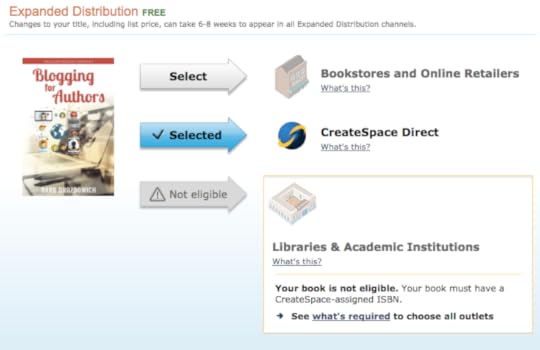


The top graphic shows the three choices for expanded distribution. The next two graphics show the help blurb for BookStores and Libraries. It would seem that CreateSpace books will be carried in other stores and available at libraries.
And interesting quote from the article by Karen Myers above:
When you use the CS expanded services, what happens is that CS uses Ingram to distribute the print book (like many other small vendors). It registers your book in the Ingram database, as “Publisher=CreateSpace” (EVEN IF YOU USE YOUR OWN ISBN, NOT ONE PROVIDED BY CS). This means when a bookstore (including online bookstores) looks for your print book, they search the Ingram database, find it under “Publisher=CreateSpace”, and if they are sensitive about Amazon as a competitor they may refuse to carry it. For example, at Barnes&Noble, where my ebooks are sold, my print books appeared as “available from third parties” (when I only used CS). Some bookstores think of Amazon as competition, and others associate CS with “indies” and scorn indies as presumed low quality.
One final comment about using IngramSparks in combination with CreateSpace – there is a difference in royalties between the two. There is an incredibly good article to explain this by Jim Giammatteo HERE.
One of the issues that was brought up in Karen’s post is purchasing ISBNs, but let’s attack that subject in a future post.
*****
I hope this post was helpful to you! Feel free to use the buttons below to share with your friends, and don’t hesitate to subscribe to get the posts directly to your inbox.
 I’m happy to announce that my Goodreads book is finally live! An Author’s Guide to Goodreads: How to Network with Millions of Readers is available on Amazon Kindle.
I’m happy to announce that my Goodreads book is finally live! An Author’s Guide to Goodreads: How to Network with Millions of Readers is available on Amazon Kindle.
It will gradually become available on other platforms as time progresses. I uploaded it to Amazon first and will start the process of the other platforms today.
To help people understand Goodreads, I’ve created a companion video course to go with. The book is currently $2.99 and the course is free.
I encourage you to buy yourself a Christmas present and start learning today!
The post Re-inventing the Wheel – part 2 of Formatting for Paperback appeared first on Bakerview Consulting.
November 28, 2016
Re-inventing the Wheel – Book Formatting for paperback
We’re back to the subject of re-inventing the wheel again this week. Several things have happened in the last few weeks to bring the topic of book formatting to my attention.
As I said in my previous “Don’t reinvent the wheel” post, I find that authors are frequently taking the advice of peers that is described as “the easiest.” Let’s be honest, most authors are creative – they create stories that I can only read – and be amazed. I certainly couldn’t create like many authors – as I’m fond of saying, I create non-fiction how-to books because I couldn’t create dialogue to save my life 
November 20, 2016
I don’t get any visitors to my blog and what to do about it
I had an interesting conversation this week – in fact this conversation, or variations on this topic are common in my world.
Authors are frustrated with the lack of traffic to their blog.

The “I don’t get any visitors to my blog” conversation. The picture above perfectly described the feelings. The ‘what the hell’ grumpy comments that I field on an almost daily basis.
In fact if I had a picture to represent this, I would picture a little boy or girl on a busy playground with their arms crossed, pouting, with the caption of “No one will play with me.”
Blogging is hard work
Developing an audience takes time
Both of these are truths – more so today than when I first started blogging.
The ‘build it and they will come’ philosophy doesn’t really work in today’s blogging world. Yes, if your site is set up properly, you will attract a certain amount of organic traffic that will gradually build over time – but not overnight!
The reality is that you need to go out and find your audience. Encourage them to come and visit.
Let’s call this networking.
Just like in a business environment, you network to increase your circle of influence. To increase the number of people you can communicate with – to increase the number of people you can share ideas with.
Starting out my blogging career as a book blogger was a great experience. What book bloggers (and many other types of bloggers) learn quickly is how to expand their audience. There are memes (group activities), there are Follow Friday activities, there is a huge list of activites and at the base of it all is chatting about the subject that we love – books.
I’ve come to the conclusion that most authors are not taught to network. Either they don’t come a ‘day job’ that requires networking, or they buy into the camp that feels that authors don’t blog. Or, it doesn’t occur to them to apply the concepts that they learn at their day job to their author job.
Regardless – I’ve come to the conclusion that my next book is going to be on networking…and then next few weeks of posts are going to be about Networking.
Before you start networking your blog, you need to envision where your audience will be. The answer to that will be dependent on what genre you write. So…your homework for this week will be brainstorming ideas as to where your audience can be found. If you are really unclear, sign up to my newsletter (http://bakerviewconsulting.com/helpful-hints-waiting/) and one of the things that I give away is a book that helps you understand the demographics on each social media.
A direct action that you can take today is to open a free account at http://bloglovin.com
Once you have a free account, you can hook up your blog feed – as a hint, your feed is likely http://yourdomain.com/feed where the ‘yourdomain.com‘ part is replaced by your domain’s name.
The next step is to find some blogs to follow.

When you click on the ‘Find Blog’ link you are presented with all sorts of choice. Each entry will tell you how many followers each has via BlogLovin’ and a little snippet of the latest post. Click on the ‘Follow’ button for each one you are interested in. There is an app for your mobile device and perhaps you can spend your commuting time or your daily coffee break commenting on blogs or just finding some new friends.
Oh…and remember – make friends – don’t ask everyone you find to read your book 
November 13, 2016
Re-inventing the Wheel Part 1 – the Author Website/Blog

Today we are going to talk about Re-inventing the Wheel – or I suppose NOT Re-inventing the Wheel.
And the focus of today’s post specifically is the author website/blog.
In several of my books I talk about the author website/blog and I offer my suggestions for not only the platform that it is optimally based on, but many other things associated with it – like how to keep it up to date and how to back up the content.
I frequently see questions in author forums asking for advice when building a website. I often cringe when I read through the answers. The answers tend to start with “I use…” or “Since I’m not very technical…” In fact, I’ve had several reviews of my books criticizing my suggestions. As many of you are aware, I favor WordPress. But many who comment – be it in author forums or in reviews of my books – think WordPress is too difficult to learn by the average author.
I disagree.

I get that most authors are very creative people – and many creative people are not also technical. I know that I tend to view the world differently than most of the creative people that I work with.
I analyze. I’m methodical. I plan.
When I considered publishing a book, one of the first people I talked to was an accountant. Although my first question was about whether or not I needed to create a business, I got a valuable piece of advice from him during that conversation. After he reminded me that I wasn’t statistically very likely to make any money, he told me that publishing a book is running a business. He said, like many businesses, there are start up costs. He suggested that I front-load my expenses – creating a loss that I could then chip away at as I started to make money.
I listened.
I listen to several podcasts while I exercise the puppy each day.
 Mocha being cozy & ready for winter
Mocha being cozy & ready for winterSome of my favorites are the Self-Publishing Formula with Mark Dawson and James Blatch and the Sell More Books Show with Bryan Cohen and Kukral among many others. They, like the vast majority of authorities in the Indie publishing arena, will encourage authors to treat publishing like a business.
Although smaller in scale than eBay perhaps, being an author these days is still a business. Decisions should be made that are the best decisions for the business. As my accountant suggested, front load your expenses. Pay someone to create a website/blog for you. Take a course to learn how to manage your website or hire some help. Websites for authors range the gamut of prices from reasonable to requiring a second mortgage. I don’t believe that beginner websites need to be complicated or expensive. I offer a selection for a very reasonable price and I take care of them. Read more on that here. I’ll have more to say about managing a website in a bit.

Keep in mind that the cost to create and maintain a website – as well as any help you hire is a business expense and can be declared on your income tax. If you are uncertain how to do that, contact your local writer’s association and they can put you in touch with a publishing savvy accountant in your area. I don’t believe in paying the tax man 1 penny more than I need to.
Back to the topic of NOT Re-inventing the Wheel.
Let’s talk about the comment about WordPress being too difficult to learn for the average author. An author is not eBay, or Forbes or another large company. What authors need to learn to do on their websites is to create and publish posts. Not too different from managing Microsoft Word to create books. An author website is not rocket science. It is used to display/promote books and communicate to readers. Once the basic information is in place, it is not changed very often. Authors don’t publish books more than a couple of times a year at most. The only content that is regularly added to an author website is posts – easily learned by anyone who can manage Word.
Let’s talk about why I suggest WordPress as the base for your author website. As I’ve mentioned above, publishing a book/being an author is a business. You need to make the right business decision to ensure that your website/blog is easily findable on a Google search, it is reasonably safe from being hacked, and on a platform that you own. You want to own your content, not be concerned that factors outside of your control will take your site away.
So why WordPress? To start to answer that question – look at what the larger businesses are doing. They have deeper pockets and have done the research – they have asked all the questions. If it is good enough for Forbes….
Alex Schaffer wrote in his article entitled 8 Reasons why Fortune 500 Companies use the WordPress CMS on Vital:
So, to say the least, content is the cornerstone of today’s commerce—and the best and brightest businesses know it. From Fortune 500 companies like eBay, Sony, GM and UPS, to national news giants like Forbes, CNN, Reuters and The NYT, to tech tycoons like Samsung, IBM and TechCrunch, heavy hitters everywhere are rolling out slick sites with full-scale content strategies developed in and supported by the WordPress CMS (content management system).
He then goes on to say that 55% of the top 1 million most visited websites in the world choose WordPress.
All you need to do is Google “What are the negatives of ______” and you will find articles telling you why to NOT choose certain platforms. Some of the choices don’t allow you to change the theme or look of your site once you choose. Some of the choices have a history of getting into a pissing match with Google and having all sites removed from Google searches – potentially devastating from the beginner author trying to be found. Some of the choices have fairly strict rules that can result in your site being deleted if you break the rules.
Why do you want a site that you own? The quick answer is so that you can pack up your content and move away. All websites live on servers – fancy computers – and each server typically houses many websites at once. Think of a server as an apartment building. One address – many residents.
What happens when one of the apartments is used as a meth lab?
All the apartments are in danger.
To get away from the danger, you pack up your belongings and move to a different address – a different apartment.
Let’s take my apartment example to the world of websites. If a server houses a website that has been black-listed for some reason all the websites on that server may be painted with the same brush. There are many reasons that a website is black-listed – perhaps it has been hacked and is now being used to distribute malware to other sites. Often when one site is blacklisted – the IP is blacklisted. In normal language, the whole server that is used to house a collection of sites has one IP address. You can be painted black just because your site is on the same server as a bad one.
Using the apartment example, when one apartment is used to create a meth lab, all the units are put in danger. The other units or apartments aren’t doing anything bad, but they are in danger because of their location.
Back to websites
If you use WordPress.org for your website and the server your site is on is black listed, you simply pack up your site and move servers. If you can’t easily move – you will remain painted black until the bad sites are corrected or removed.

Google has lots of rules they want websites to follow. Lots of factors go into determining how Google views a website. Aside from whether your site is black-listed, Google expects your site to load quickly, be easily searchable by it’s bots and mobile responsive to name a few.
Do I expect you to know and understand all these things? Not necessarily. But I do expect you to make an educated business decision – perhaps with guidance – that will benefit your business over the long haul. Perhaps by asking for guidance from someone who specializes in author websites.
And if the only reason someone has for choosing a platform for a website is because it is easy – walk the other way.
Stop trying to re-invent the wheel – it’s already been invented.
***
If you enjoyed this post, please subscribe to the blog over there –>
I am giving away 2 free books as well as a handful of videos to help you jumpstart your understanding of technical hurdles faced by authors. To start, enter your email address here.
To keep you up to date on publishing news…the Goodreads book has a cover and is edited. Just working on the screencasts that make up the accompanying course. A few more weeks and I should have it available…fingers crossed!
The post Re-inventing the Wheel Part 1 – the Author Website/Blog appeared first on Bakerview Consulting.
October 26, 2016
Social Media Rock Star (Infographic)
Today’s infographic was originally posted here: http://www.onblastblog.com/social-media-cheat-sheet/
Today I have an all in one post for your education! Image size, times to post, and some keyboard shortcuts.
Enjoy!

The post Social Media Rock Star (Infographic) appeared first on Bakerview Consulting.
October 17, 2016
Formatting for Ereaders
Today we are going to attack the subject of formatting for eReaders.
As children we are all taught to read on paper books. Those cute and colorful gems were designed to help us understand the words with the use of pictures and were entertaining enough to encourage us to continue along.

Our regular trips to the school library or perhaps the public library are fond memories and for many authors are the beginnings of a love a reading or perhaps the desire to be a writer.
The look, the feel, the smell of a paper book is something that evokes memories – perhaps is a source of comfort.
It’s not at all surprising that many authors focus on the paperback book when they are thinking about publishing.

Looking at the example above of one of my books, we see so many things to focus our attention on.
What does the chapter title or chapter head look like?
Do we use drop caps on the first line?
Do we use capitalization on the first line?
Do we indent at the start of every paragraph?
What font do we choose?
The list of choices are endless it seems. To many, choices like the list above are very important – especially those authors who primarily read books in paperback from.
When creating a paper book, these choices are made and the finished product will reflect our vision. And since it is printed, the look and feel will not change – it is static.
In my experience, many authors assume that the same choices can be made for ebooks – and they can. However, what many authors are unaware of, is that the way the ebook version of their novel is viewed is dependent on factors outside of their control.
Let’s talk about some of these factors.



How are ebooks read? Three of the common devices are pictured above. A Tablet, a laptop and an ereader (Kindle, Kobo, Nook and others) are common choices. Research tells me that many people read books on their smart phone. Although I can’t imagine regularly reading on a smart phone, I have and do read books on all of the above. I have a Kindle, a Nook, an iPad and a laptop.
The first thing that we can tell from the above is that there is a variety of screen sizes, not to mention the variety of other factors. We know from Amazon, that they offer free reading apps so that you can read your Kindle books on almost any device. The same is true of other retailers, and even some publishers.
What many authors don’t know is how much control is allowed over the look and feel of the book being read on a device. All devices and reading apps have some sort of a settings menu. I admit than many don’t know these settings are present and read using the default settings of their device.
On my iPad’s Kindle app, if I tap in the upper right of the screen I can get what are called View Options
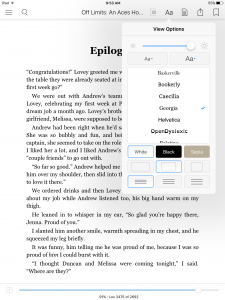
You’ll notice that not only can I control the brightness of my screen, but I can control the font size as well the color – I can even choose which font I want to read the book in – I’m presented with a small handful of choices.
I also have the app from Harper Collins :
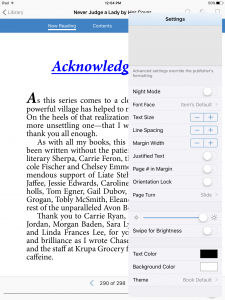
It has a settings menu that allows for even more customization of what I’m reading – it has a lot more power than the choices on the Kindle app. I’m offered a choice of 60 different fonts. I’m allowed to increase or decrease line spacing and margin width – even change the justification of the text.
These choices – this capability is not limited to the above two examples. In fact all reading devices will allow customization of the reading environment to some extent.
Let’s talk about what this means with some screenshots. I now format using Vellum (and yes, I’m a huge fan) When I format with Vellum, it allows me to see how the ebook will look on a device.
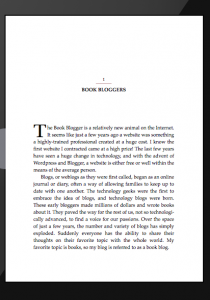

The graphic on the left is what Vellum tells me what the ebook will look like, and the graphic on the right is what the default setting looks like on my Kindle app. You’ll notice the chapter header is different – the underline is gone and the all caps are gone. The drop cap that I carefully chose is gone on the Kindle app version.

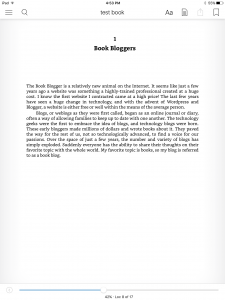
If I had better eyesight and read a book in a smaller font size, what takes up one page on the default according to Vellum, is barely half a page on my Kindle app. This clearly explains why ebooks don’t have page numbers – or the page numbers change. On the Kindle app, I’m offered with percentages of amount read. Different devices offer different methods of helping you understand how much you have read – but clearly, the amount can change from reader to reader.

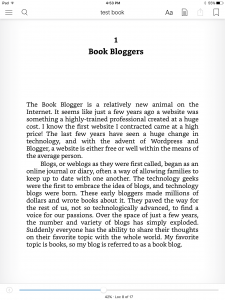
In actual fact, if I change the font family, I can change the whole look and feel of the book as you can see above.
So…what do we learn from this?
The obvious fact to point out to the people who exclusively read paper books, (yet sell their books in an eformat) is that what you choose for your book to look like, is not necessarily what it will look like to your readers. Although you many be offered with choices by the person/company who formats your book, those choices might not be reflected to your readers. When readers complain about ‘formatting issues’ they might be of their own making because they changed their settings.
If you sell your books in an eformat, I suggest that you get yourself some free reading apps and see what your books can look like to your readers 
October 3, 2016
Demystifying Google’s new Popup rules
Today’s task is to make some sense of Google’s new rules regarding popups.

We have all been told that getting readers to subscribe to your mailing list is the new key to the kingdom and the best way to do that is to use a popup subscription form to encourage signups.
We can argue whether those two statements are correct until the cows come home but that’s not the focus of this post.
As the graphic above indicates, Google is only concerned with popups on mobile devices with it’s latest announcement. Just a quick peek at Google stats will show that more and more sites are accessed primarily via mobile devices these days. Because of this, Google is focusing on mobile use. If you remember, Google previously took aim at sites that didn’t meet their version of mobile friendly. After a bit of last minute scrambling, many sites now comply with the guidelines.
You can check your site at this link.
Now that Google has us toeing the line with respect to being mobile friendly, it is setting it’s sights on popups. Even I had to dig out a dictionary when I first read Google’s pronouncement.
A direct quote from Google’s blog post in part reads:
Pages that show intrusive interstitials provide a poorer experience to users than other pages where content is immediately accessible. This can be problematic on mobile devices where screens are often smaller. To improve the mobile search experience, after January 10, 2017, pages where content is not easily accessible to a user on the transition from the mobile search results may not rank as highly.
Really….what the heck is an “intrusive interstitial?”
Clearly, someone without a degree in Engineering needs to write their blog posts 
September 15, 2016
The Good, The Bad & The Ugly of WordPress Hosting
I ran across this outstanding infographic today and just HAD to share it! The site it was originally found on is CodeinWP.com

The post The Good, The Bad & The Ugly of WordPress Hosting appeared first on Bakerview Consulting.
September 11, 2016
23 Top Book Promotion Sites for budget conscious authors

Today we are going to talk about choosing sites to promote your book.
So the tagline of this post should be:
What to look for when choosing a book promotion site?
There is an endless debate amongst authors as to which site will bring the most sales. I actually manage several sites that promote books. I know the traffic that they get and I know that not all books attract the same degree of attention. The audience is different in almost all cases.
 I have a Kindle Countdown deal coming in just over a week for The Author’s Guide to Working with Book Bloggers, so I thought I’d take the opportunity to test out a selection of services.
I have a Kindle Countdown deal coming in just over a week for The Author’s Guide to Working with Book Bloggers, so I thought I’d take the opportunity to test out a selection of services.
This is not only the first book that I wrote, but it is an award winner and available in kindle, paperback as well as audiobook formats. Not only has it sold a lot of copies and is available in all formats, it has a good track record of helping a lot of authors understand the book blogging world. I put it in KDP Select a few weeks ago for a number of reasons – honestly, they first reason was to play with Amazon’s new ad system (we’ll talk about that another day).
In the table below, you’ll see a selection of sites along with some details about each site. I’m totally aware that the number of sites available to promote books seems endless and we can’t possibly talk about them all in one post. The list below is the list of promotional sites I’m approaching for my upcoming sale. The sale that I’m promoting is for a 99 cent book – not a free book. Many sites only accept submissions for free books.
NameURLpromo costFree booksCheap booksNotes
Ask Davidaskdavid.com$15XXone payment - unlimited books
Awesome GangAwesomeGang.comOptional $10XXpromotion of books regardless of sale
Bargain Booksybargainbooksy.comprice varies by genreXX
Booktasktikbooktastik.comprice varies by genreXX
Choosy Bookwormchoosybookworm.comfree - $70XX
Ebook Bargains UKhttp://www.ebookbargainsuk.com/variety of packagesXXwide variety of packages targetted at the UK
Ebooks Habitebookshabit.comfree to $19XX
Ereader IQereaderiq.comprice varies by genreXXseveral choices of promotional vehicles
Ereader News todayereadernewstoday.comprice varies by genreXX
Free Kindle Booksfkbt.comvariety of packagesXX
Free Books Hubfreebookshub.com$10-20XX
The Fussy Librarianthefussylibrarian.comprice varies by genreXXbooks quite a bit in the future
Indies Unlimitedindiesunlimited.comfreeXXListing the day of
Just Kindle Booksjustkindlebooks.com$15 - $35XX
Kindle Books & Tipshttp://fkbt.com/varity of packagesXX
the Kindle Book Reviewhttps://www.thekindlebookreview.net/v... of packagesXX
Kindle Nation Dailykindlenationdaily.comvariety of packagesXX
My Book Cavemybookcave.comfreeXX
People Readspeoplereads.comvariety of packagesXX
Planet Ebooksplanetebooks.net$19.95-$59.99XX
Read Freelyreadfree.lyfreeXX
Reading Dealsreadingdeals.comfree - $15XX
As you can see in the table, the prices range from free to several hundred dollars per promotion. Almost every site offers a range of packages – or should I say a dizzying array of prackages.
All book promotion sites will generally promote a book via:
social media promotion
newsletter distribution
posting on a site

Social Media Promotion
Quite a few sites that I looked at offered a certain number of tweets per day, or per week. Several offered posts on a Facebook page. Regardless of how many likes a Facebook page has or how many followers a Twitter stream has, we know from the literature that only a small portion of those likes/followers will even see a post. It is also accepted in the literature that although the social media is a great place to chat and make friends, it isn’t really the place for the hard sell. Frequently the ‘Buy my Book” messages are tuned out – and in the case of Facebook, the algorithm will prevent these promo posts from appearing in most people’s timelines.
Because of the above, I question the usefulness of this sort of promotion.

Newsletter Distribution
It is fairly well accepted in the literature that the response from an email vastly out reaches any other form of delivery of information. People are more likely to open an email that lands in their inbox than visit a website. From this, one can assume that a promotion via newsletter would be very effective if the audience is interested in your genre of book.
When looking at the numbers provided by the promotion site, you aren’t interested in over all subscribers – as this number is useless – lacking in details. You are interested in what numbers of subscribers are interested in the genre of book you are interested in promoting.
What’s that saying? Don’t be dazzled by bullshit….

Posting on a site – either a blog or a website
Most websites that do book promotion get decent traffic numbers, but in my experience readers don’t search out a book promotion site to find their next read. If they have subscribed to this site, they have reason to pay attention to the latest posts; if they follow the site on BlogLovin’ or other similar aggregator, they likely will pay attention to what is shared. People just happening by, are not really likely to buy a copy of a book. In my experience, people who find a book promotion site via a Google search are authors looking for a place to promote their book – not readers to buy one.
In next week’s post, I’ll compare and contrast some of the services that I end up being accepted to for the upcoming kindle countdown promotion.
In the meantime, see below for the latest news on the book front…
*****

If you haven’t already noticed I’m giving away a couple of free books and some videos aimed at helping with some common tech issues. If you are interested in getting some free books, click HERE.
My re-write of the Goodreads book is now in the hands of my editor. I’m impatiently waiting for her thoughts and hope to have it on Amazon by mid October.
The post 23 Top Book Promotion Sites for budget conscious authors appeared first on Bakerview Consulting.
August 21, 2016
How to Add Amazon Affiliate links to a post/page, sidebar & text link
It’s done – I’ve redone the video that explains how to add Amazon affiliate links. There were some major changes made a few months ago which created some confusion for people and questions on the current YouTube video.
I’ve created an update version of the video and also expanded it to talk about sidebars as well as text links.
Let me know what you think of it
*****
As for current news…there are two box sets available for purchase and two of my books have won Silver awards from Dan Poynter’s Global Ebook Awards! If you haven’t already, subscribe to the blog or enter your email address to get 2 free books!
The post How to Add Amazon Affiliate links to a post/page, sidebar & text link appeared first on Bakerview Consulting.








